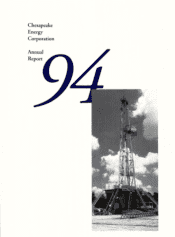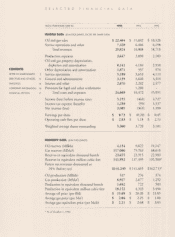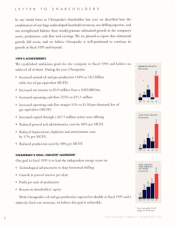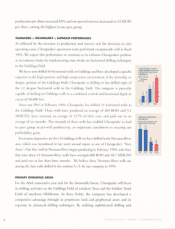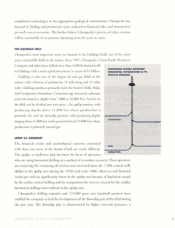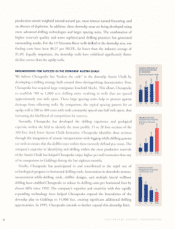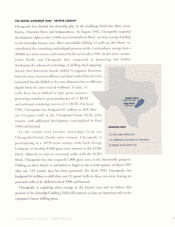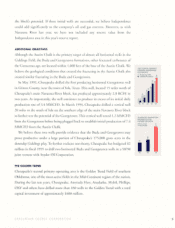Chesapeake Energy 1994 Annual Report Download - page 11
Download and view the complete annual report
Please find page 11 of the 1994 Chesapeake Energy annual report below. You can navigate through the pages in the report by either clicking on the pages listed below, or by using the keyword search tool below to find specific information within the annual report.
the block's potential. If these initial wells are successful, we believe Independence
could add signifIcantly to the company's oil and gas reserves. However, as with
Navasota River last year, we have not included any reserve value from the
Independence area in this year's reserve report.
ADDITIONAL OBJECTIVES
Although the Austin Chalk is the primary target of almost all horizontal wells in the
Giddings Field, the Buda and Georgetown formations, other fractured carbonates of
the Cretaceous age, are located within 1,000 feet of the base of the Austin Chalk. We
believe the geological conditions that created the fracturing in the Austin Chalk also
created similar fracturing in the Buda and Georgetown.
In May 1992, Chesapeake drilled the first producing horizontal Georgetown well
in Grimes County, near the town of lola, Texas. This well, located 15 miles north of
Chesapeake's main Navasota River block, has produced approximately 2.8 BCFE in
two years. As importantly, the well continues to produce in excess of its initial daily
production rate of 3.4 MMCFD. In March 1994, Chesapeake drilled a vertical well
20 miles to the south of lola on the southern edge of the main Navasota River block
to further test the potential of the Georgetown. This vertical well tested 1.2 MMCFD
from the Georgetown before being plugged back to establish initial production of 7.4
MMCFD from the Austin Chalk.
We believe these two wells provide evidence that the Buda and Georgetown may
prove productive under a large portion of Chesapeake's 175,000 gross acres in the
downdip Giddings play. To further evaluate our theory, Chesapeake has budgeted $2
million in fiscal 1995 to drill two horizontal Buda and Georgetown wells in a 50/50
joint venture with Snyder Oil Corporation.
THE GOLDEN TREND
Chesapeake's second primary operating area is the Golden Trend Field of southern
Oklahoma, one of the most active fields in the Mid-Continent region of the nation.
During the last ten years, Chesapeake, Arnerada Hess, Anadarko, Mobil, Phillips,
OXY and others have drilled more than 450 wells in the Golden Trend with a total
capital investment of approximately $400 million.
SUCCESSFUL DRILLiNG
CREATES ADDITIONAL
LOCATIONS
P,odocrrg wells ,
r Urrdriled ksorotrorrs
LEASEHOLD INVENTORY:
PROSPECTS FOR
FUTURE GROWTH
(Gross cores
Is thoorcrrds(
Iii
CHESAPEAKE ENERGY CORPORATON 9

